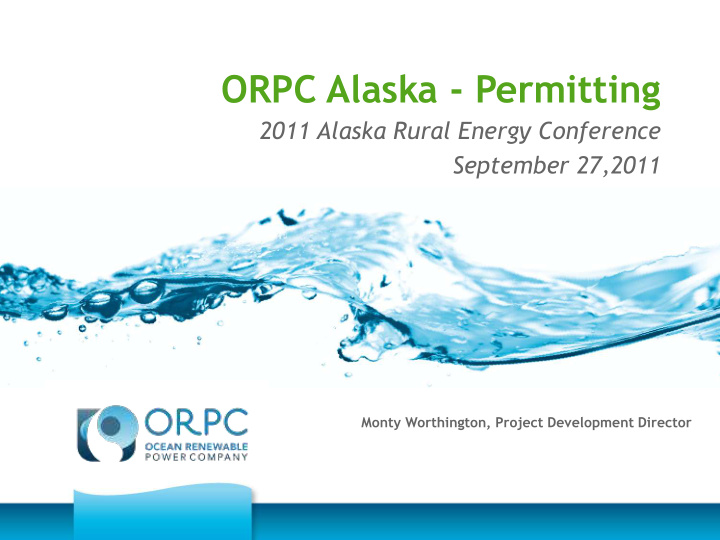



ORPC Alaska - Permitting 2011 Alaska Rural Energy Conference September 27,2011 Monty Worthington, Project Development Director
Ocean Renewable Power Company Overview • Maine-based developer of Founded in 2004 with • hydrokinetic power systems executive offices in Portland, and projects that turn ocean Maine and project offices in and river currents into reliable supplies of clean, Eastport Maine, and predictable electricity Anchorage, AK 28 employees, 4 in Alaska • Proprietary technology • including OCGen ™, TidGen ™, and RivGen ™ power systems Project sites in Cook Inlet and • Nenana, AK, and Eastport, ME, and partnering on projects in Nova Scotia Beta Turbine Generator Unit • (TGU) deployed in March 2010 2
ORPC Philosophy • Community driven and focused • Technology development and environmental considerations are intrinsically connected 3
Permitting and Licensing Tidal and River Hydrokinetic Projects – Federal Energy Regulatory Commission (FERC) is the • federal agency asserting jurisdiction Developed Pilot Licensing Process to facilitate getting projects • into the water, proposed in 2007 and adopted in 2008 Designed to facilitate getting projects and technology • deployed Must be small (under 5 MW) and short term (5 years • recommended) • To date two Final License Applications (FPLAs) have been submitted to FERC • ORPC has submitted one of these as well as a Draft Pilot License Application (DPLA) for the Cook Inlet Tidal Energy Project 4
The FERC Process • Apply for preliminary permit which gives applicant 3 years of priority to file a license application for the area • Perform environmental, site characterization work, and project engineering • Submit Draft License Application within two years • Respond to Additional Information Requests (AIRs) • Submit Final License Application • Apply for all other permits and authorizations • Receive Project License, other necessary permits and begin construction 5
What Does it Take? ORPC’s Cobscook Bay Tidal Energy Project FPLA, Fundy Tidal’s (Nova Scotia) Project Description 6
Other Permits Required • US Army Corps of Engineers Section 10 • Alaska Department of Natural Resources Submerged Land Use Permit or Lease • Alaska Department of Fish and Game Fisheries Habitat (river) Or Special Area Permit (Refuge’s Sanctuary’s etc) • Alaska Department of Natural Resources Water Rights (river) • ACMP review – not anymore • United States Coast Guard Consultation and Review 7
Fire Island Environmental studies completed in 2009-2010 • Fish study, beluga monitoring project • FERC Licensing • Submitted Draft License Application on 3/30/09 • • Complete responses to AIR’s issued in 6/09, now due 10/12 • Complete 2 years of beluga monitoring and submit draft BA Perform 6 more months of passive hydroacoustic • monitoring Perform 1.5 more months (May – June) visual • observations Submit FPLA by 10/13 • Complete other permit applications by 1/1/14 • • Secured ADNR submerged land use permit for scientific work through 2014 • Will need additional USACE, ADNR, Biological Assessment etc 8
East Foreland • Preliminary permit issued in March 2009 • Environmental Work and Project Design Perform ADCP and bathymetry work for preliminary project design 2011 • • Perform Environmental studies in summer 2012 • Consult with Agencies on required environmental data collection • Complete 1 year of Beluga monitoring • Perform fish literature review, studies as required • Geophysical data collection for engineering Draft License Application submitted by 10/12 • • Develop monitoring plans • Complete stakeholder consultations • Submit Final License Application in January 2013 • Apply for other permits (ADNR, USACE, etc) • Respond to AIRs during 6 month expedited review Receive license • • Begin First Tidgen ™ Deployment in Alaska in June 2013! 9
Nenana RivGen ™ Power Project Permits received from USACE, ADNR and ADF&G for • Bottom Support Frame an Anchor System testing in August Permits received by UAF for fish study, and fish study • anchoring of equipment from ADNR, USACE and ADF&G in August Project Licensing • • Exploring Verdant Exemption with Golden Valley Electric Association Sales of power will not justify licensing costs – ie cheaper to give the • power away than acquire license to sell it … Will still require USACE, ADF&G, ADNR permits and USCG consultation • for project installation 10
In Conclusion • The FERC pilot process is being developed to facilitate getting pilot projects in the water, but has yet to be proven The costs and level of effort for licensing under this short • term license ( 5 years suggested term) and small scale (under 5MW) are quite high The pathway from a FERC pilot project license to a • commercial license has not been defined and needs to be addressed • The FERC process may be prohibitively expensive for small scale projects in rural Alaska This may be an opportunity for the State of Alaska to • develop capacity and take a role in the permitting of small scale rural tidal and hydrokinetic river projects. 11
Thanks for listening 12 www.oceanrenewablepower.com
Recommend
More recommend